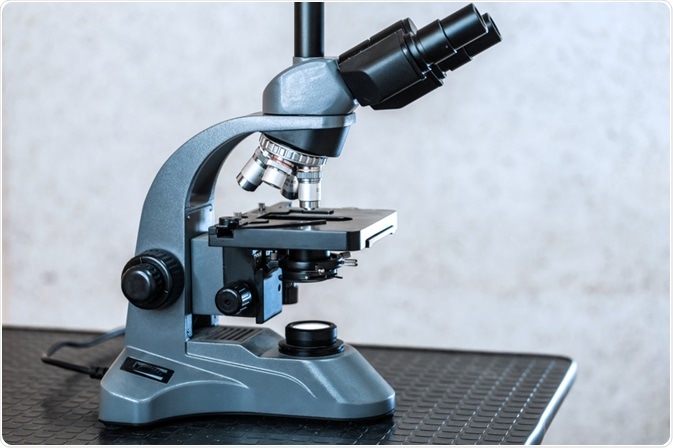Portable optical light microscopes are widely used tools in the field of microscopy. Found in laboratories both large and small, as well as schools and colleges, they are a simple and elegant solution that helps scientists peer into the microscopic world and reveal structures invisible to the naked eye.

Image Credit: Trymybest/Shutterstock.com
Although they have been surpassed in resolution within the last century by tools such as electron microscopes, atomic force microscopes, and super-resolution microscopy methods, they are still ubiquitous in laboratories, classrooms, and field studies across the developed and developing world. Whilst limited in their application and functionality, they still have their advantages. Some advantages and disadvantages are listed below.
Advantages
A key tool in modern cell biology, several features make light microscopy ideal for the imaging of biology in living cells. These include:
- Easy to operate – As they are simple to set up and can be operated by anyone with minimal training and knowledge, portable microscopes are accessible to any user.
- Inexpensive – Portable microscopes are much cheaper than other microscopes, including electron microscopes (which can cost upwards of several thousand dollars.) This makes them ideal instruments for schools, colleges, or research projects with a limited budget. Good quality examples can be purchased for relatively small amounts of money, with some good examples only costing around $100. Replacement parts are cheap and easy to source.
As they are inexpensive, light microscopes are useful in developing countries, especially outside of wealthy urban centers, governmental institutions, and universities.
This makes them suited to identifying disease-causing organisms in outbreaks in a short space of time. The Global Focus microscope is one portable, battery-powered microscope that has been developed for this purpose.
This is an inverted bright field and fluorescence microscope that can magnify an image up to 1000x and can be manufactured for around USD 240. It is proving especially useful for the detection of Mycobacterium tuberculosis, a common disease in underdeveloped communities, from sputum smears.
- Space – As portable microscopes tend to be small, they do not take up much space in the laboratory. Where space is a premium, multiple microscopes can be set up, so studies can be done in tandem with each other as part of an overall project.
- Easily transportable – Being light and portable, these microscopes can be deployed in the field at a minimum of cost and effort. This makes them especially ideal for field studies, including setting up mobile laboratories in outbreak zones.
- Non-perturbing – The non-destructive nature of light for observation of cellular structures means that living cells can be imaged for long periods. Cell dynamics can, therefore, be studied effectively using these microscopes.
Disadvantages
- Low resolution – Although a light microscope is ideal for viewing certain subcellular structures, the resolution is still relatively low. Observation is limited to structures at a lateral distance of less than half the wavelength of light apart. At this scale, structures will become blurry and hard to identify, and even using additional lenses does not do much good for improving resolution. Alternative methods, including super-resolution microscopy and electron microscopy, are needed to image structures that would otherwise be rendered invisible. Atomic structures and fine details of proteins and nucleic acids are a couple of the structures that portable microscopes cannot observe.
- Inability to provide a 3D rendering of structures – whilst three-dimensional shape can be inferred using stereo microscopy from the depth observed, portable microscopes cannot provide in-depth information on the three-dimensional structure. Equipment such as scanning tunneling microscopes and scanning electron microscopes are better suited for this.
- Low magnification caps – Some portable microscopes, especially those at the lower end of the cost scale, can come with very low magnification caps (as low as 40x.) The most commonly used lens when operating a portable microscope is 10x, which gives a magnification of 100x when used in conjunction with a 10x ocular lens.
- Inability to operate in darkness – Portable light microscopes must be used in certain conditions. Darkness is one of the conditions it is nearly impossible to operate one in. Artificial light sources or built-in illuminators can be added to the unit to mitigate this problem, however.
Summary
Portable microscopes are cheap, versatile options for academia, education, and research studies. They are simple to use and widely available and do have some advantages, especially where cost is a consideration, though they are not suitable for a variety of studies that demand high-resolution imaging of delicate cellular and atomic structures, which can be on the nanomolecular scale.
Sources
Thorn, K (2016) A quick guide to light microscopy in cell biology MBoC Vol. 27 Issue 2 pgs 219-222 DOI: https://www.ncbi.nlm.nih.gov/pmc/articles/PMC4713126/
Miller, A.R et al. (2010) Portable, Battery-Operated, Low-Cost, Bright Field and Fluorescence Microscope PLoS ONE Vol. 5 Issue 8 e11890 DOI: https://doi.org/10.1371/journal.pone.0011890
Last Updated: Jan 17, 2020